Curious what you've been told about, or for instructors what you teach about tenon diameter. I start beginners and new bowl turners with the guidance that the jaws should be "close to a circle" with just a little space between them. Realizing, of course, that for a small bowl the tenon diameter (hence the jaw gap) can be bigger. A colleague today challenged the axiom a bit, saying the the way the profile jaws on,.say, a Talon or Stronghold chuck are shaped, the contact points need not be all that close together. Even mentioned a chart that gives bowl size and recommended tenon size. Is there some other rule of thumb that I can/should offer to the novices?
-
Beware of Counterfeit Woodturning Tools (click here for details) -
Johnathan Silwones is starting a new AAW chapter, Southern Alleghenies Woodturners, in Johnstown, PA. (click here for details) -
Congratulations to Peter Jacobson for "Red Winged Burl Bowl" being selected as Turning of the Week for April 29, 2024 (click here for details) -
Welcome new registering member. Your username must be your real First and Last name (for example: John Doe). "Screen names" and "handles" are not allowed and your registration will be deleted if you don't use your real name. Also, do not use all caps nor all lower case.
You are using an out of date browser. It may not display this or other websites correctly.
You should upgrade or use an alternative browser.
You should upgrade or use an alternative browser.
Tenon diameter axioms
- Thread starter Jamie Straw
- Start date
I only use dovetail jaws and what you express about the tenon sized to be totally clamped by the entirety of the jaws is what I do, that is the best way. I very seldom make the height of the tenon more than an 1/8 of an inch. The Oneway Stronghold I have has those serated jaws and I only have that in case a pro who is doing a hands on wants that chuck, myself I don't use it. But the talons have dovetail jaws and they are used like all the other jaws on the other chucks (a hold as close to 100% encircled by the jaws). Keep teaching that way!
john lucas
AAW Forum Expert
I agree with bill. The Oneway jaws have a different shape and were designed that way so they could grip on tenons of different sizes. Dovetail tenons like my vicmarcs work the best when closed most of the way. That being said I often grip with jaws open quite a ways and have never had a problem with this.
- Joined
- Feb 28, 2021
- Messages
- 1,231
- Likes
- 1,091
- Location
- Roulette, PA
- Website
- www.reallyruralwoodworks.com
I've had my best results as well with the "jaws form a circle" rule - not only with my dovetail jaws, but also the barracuda jaws (from PSI) both sets I have had "Bowling" (the wood's the ball, Im the pins?) otherwise - only once each though to date.. barracuda jaws , tenon just slipped out (but then I had it formed straight and level, I have since slightly dovetailed the tenons for the barracuda jaws, so the straight gripper jaws sort of flatten the corners of the tenon) and with the dovetail jaws, they gripped only at 8 little points each, and the tenon cracked and separated starting right exactly at one of those points (couldn't see any other way the crack would have formed) , and if I'd had tenon properly formed , they'd have had a far better grip, so even if the crack had developed naturally, bowl still wouldn't have come off. With the 'cuda jaws I am not so concerned with getting the tenon "just right" , so I can easily just eyeball it to "pretty close" which is perfectly good enough judging by jaw impressions left over after de-chucking a project.
I believe your axioms need some conditional logic to deal with the green wood and then second turned case. I don’t believe the chuck will close securely on a green turned tenon, after drying.
- Joined
- Apr 27, 2004
- Messages
- 8,655
- Likes
- 5,017
- Location
- Lakeland, Florida
- Website
- www.hockenberywoodturning.com
Curious what you've been told about, or for instructors what you teach about tenon diameter. I start beginners and new bowl turners with the guidance that the jaws should be "close to a circle" with just a little space between them.
What I teach is - with #2 jaws 2” jaws is to make the tenons in green wood 2.5” diameter.
Then the dried bowl tenon can be turned round to 2” and fit nicely for returning.
A flat to rest on the tops of the jaws adds stability.
vicmark publishes the perfect circle diameters in their handbook
My jaws perfect circle is 48mm ( 1.89”)
These same jaws hold at 2.5” ( 63.5mm) extremely well
2.5 tenon will be gripped perfectly well for turning a bowl. In fact the slightly larger tenon is superior for roughing less chance of beginner shearing off the tenon with a bevel misadventure.
The complete circle grip is the strongest with dovetail jaws and it does not mark the wood.
As you noted the ONEWAY jaws design grips almost equally well over a range of tenon diameters.
One note: the nova bird beak jaws don’t hold larger tenons nearly as well as dovetail jaws or ONEWAY jaws.
Last edited:
I always turn green wood and whichever Vicmarc chuck I use, I leave at least 1/4" gap between the jaw segments when tightened on the tenons. When I second turn the bowl or piece and true up the tenon, usually I have about 1/16" gap between jaw segments, which is about as true to a circle meaning full contact as I can get. I like the tenon to be tall enough so the jaws can rest against the bottom of the bowl or piece, which adds to the support of the piece. I do not want the tenon top to touch the chuck, just close.
I have a very large compass that I open to the outer diameter of the tenon. When I have turned the bowl bottom flat to where I want the tenon, I lay the compass on the rest with the steel point held with my right hand fingers about 1/2" away from the wood and with my left hand just touch the pencil to the wood. Adjusting back and forth until the steel point is right over the pencil mark, I let the pencil ride on the wood to make my tenon circle.
I have a very large compass that I open to the outer diameter of the tenon. When I have turned the bowl bottom flat to where I want the tenon, I lay the compass on the rest with the steel point held with my right hand fingers about 1/2" away from the wood and with my left hand just touch the pencil to the wood. Adjusting back and forth until the steel point is right over the pencil mark, I let the pencil ride on the wood to make my tenon circle.
- Joined
- Apr 18, 2009
- Messages
- 145
- Likes
- 65
Here is an exception to using the gap between jaws for gaging the perfect circle. Axminster chuck jaws in the larger sizes are machined to have about a 1/4" gap when in perfect circle.
Dave Landers
Beta Tester
I teach the "near perfect circle" thing. For Vic (and other dovetail). The other thing that I teach as important is the flat ring parallel with the bottom of the bow). The face of the jaws should seat on this flat place, and it that gives the jaws resistance against torque that would pry the bowl from the jaws. If that "flat" isn't flat, then there's less for the bowl to seat on. Of course, this only applies to jaws with a wide face (like Vic's dovetail jaws). Nova bird beak things are a completely different animal.
There are a ton of exceptions, like green wood, etc but you gotta know the rules (and the why's) before you can know when to break them.
There are a ton of exceptions, like green wood, etc but you gotta know the rules (and the why's) before you can know when to break them.
One thought about newbies is that they will inevitably overshoot the mark sometimes. Some method of marking or gauging the desired diameter should be part of the method, and maybe a little acceptance of a slightly oversize tenon as they get the hang of it.
I will say, when I was new, I had a lot of tenons break off in my Nova chucks. Presumably it was due to the tenons being oversize or the edge poorly shaped. (In hindsight, I think it was a combination of making a dovetail, when they actually had the birdbeak jaws, and not getting a good flat on the bowl bottom for the jaws to press against)
I will say, when I was new, I had a lot of tenons break off in my Nova chucks. Presumably it was due to the tenons being oversize or the edge poorly shaped. (In hindsight, I think it was a combination of making a dovetail, when they actually had the birdbeak jaws, and not getting a good flat on the bowl bottom for the jaws to press against)
Joe, thanks for that, I guess in that case you would just have to measure the inner diameter of the tenon bearing surface of the jaws, maybe take them off of the chuck, lay them upside down space them then measure, you would only have to do that once. This is distance to me is only necessary when turning green wood. Once turned, the gap should be very close to closed, 1/16" to me, is close enough.Here is an exception to using the gap between jaws for gaging the perfect circle. Axminster chuck jaws in the larger sizes are machined to have about a 1/4" gap when in perfect circle.
Dave, I used a 3/4" skew to flatten and parallel that surface for the Vicmarc jaws to rest against. It nor only strengthens the hold but helps to true the piece to the swing of the lathe. My final cut on the outer edge of the tenon is made with that skew, makes a nice crisp angle and corner, practice makes perfection!
Picture is of a monster piece of oak on my big Vicmarc chuck, right at the 20" swing of the Powermatic and of a tenon on the outer bowl.
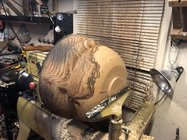
I'm curious what process folks use to make the perfect circle tenon diameter for dovetail jaws. I usually make my tenons a bit larger to avoid overshooting (undershooting?) and making the tenon too small. Talking about dovetail jaws here.
The complication is that the taller/deeper the tenon, the more the diameter changes from the top (outside) of the tenon to the bottom where it meets the base. Do you carefully measure the depth of the tenon and set the starting (top) diameter accordingly? Or always use the same depth of tenon and have a starting diameter that you know works?
I've had good results with slightly oversized tenons as long as the base is perpendicular to the ways, the tenon angle is correct and the point where the tenon meets the base is sharp, no extra wood to prevent the jaw seating. I'd like to start making more perfect circle diameters if I can learn an efficient way to do so.
The complication is that the taller/deeper the tenon, the more the diameter changes from the top (outside) of the tenon to the bottom where it meets the base. Do you carefully measure the depth of the tenon and set the starting (top) diameter accordingly? Or always use the same depth of tenon and have a starting diameter that you know works?
I've had good results with slightly oversized tenons as long as the base is perpendicular to the ways, the tenon angle is correct and the point where the tenon meets the base is sharp, no extra wood to prevent the jaw seating. I'd like to start making more perfect circle diameters if I can learn an efficient way to do so.
Well, I do prefer a recess for my bowls. With a recess, I think it is critical for the recess diameter to be very close to the chuck jaw diameter when expanded. If your recess is bigger than the closed jaws, the only metal contact is one point near the center of the jaw. I think you can have considerably more 'wiggle' room if you are using a tenon because you will have the corners of the jaws digging into the tenon, not just the round part of the jaw. Seems like there is always the proper size tenon but your jaws are either too big or too little. I have heard proper tenon size is in the 1/3 to 1/2 the diameter of the piece. I have done 1/4 the diameter and not had problems, and 1/2 the diameter is just way too big. I guess it depends. I do consider the dove tail to be superior to a straight tenon.
robo hippy
robo hippy
First off the Oneway chucks all have the cerated jaws and one can hardly discuss about it if one doesn't have or never use the Oneway chucks, and yes you can order dovetail/smooth jaws for any and all the sizes.
I'm not going to discuss the Vicmark or other chuck makes, what I do know is that I can use the Oneway cerated jaws for the size of tenon that I feel is right for the size of turning, I'm not forced to turn an exact size to fit the chucks jaws.
The other thing about the exact dovetail shape and size, I'm quite sure that a more square tenon shape is better than a too acute shape, of course the Oneway uses straight tenons for holding a tenon and also the dried tenon that was turned larger can still be held just fine with the cerated jaws, or turned round and smaller, though I must admit I use mostly a recess to hold my turnings, as I find id a safer and stronger hold, never had those often told ID'sthat you will split the wood with a recess, I do also know I've never had this (see below) happen.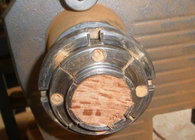
I'm not going to discuss the Vicmark or other chuck makes, what I do know is that I can use the Oneway cerated jaws for the size of tenon that I feel is right for the size of turning, I'm not forced to turn an exact size to fit the chucks jaws.
The other thing about the exact dovetail shape and size, I'm quite sure that a more square tenon shape is better than a too acute shape, of course the Oneway uses straight tenons for holding a tenon and also the dried tenon that was turned larger can still be held just fine with the cerated jaws, or turned round and smaller, though I must admit I use mostly a recess to hold my turnings, as I find id a safer and stronger hold, never had those often told ID'sthat you will split the wood with a recess, I do also know I've never had this (see below) happen.

Wow! I've never seen this happen either, I've always used the largest diameter tenon the wood and my chucks allow. I did mention I only use Vicmarc chucks and on my first harbor freight lathe I had a PSI chuck both of which had tapered jaws if I remember correctly. The one thing I do I think more than many others I will not turn as fast until my finish cuts and even then less than 900 RPMs. I'm getting to where I can get nice clean cuts at lower speeds than I'm seeing on most demonstrations, probably slower finishing than most turners but I think much safer for me at least.
The reason I always measure with the compass different green woods and even cured woods compress in the tenon area differently so very hard woods I will close the gap a bit and softer hard woods I open it a tiny bit, being careful not to crush the integrity of the tenon.
With all the different styles of chucks being used, my advise might not be of much use with others, just has worked great on Vicmarcs and PSIs for almost two decades I've been turning.
Recess turning has always scared me because I turn green and start with a tenon so naturally clean up the tenon on second turnings. I do like the idea that you can use a recess then make it the base and look like it was a well designed one with not much extra work. I believe I saw Stuart Batty do that in one of his videos.
The reason I always measure with the compass different green woods and even cured woods compress in the tenon area differently so very hard woods I will close the gap a bit and softer hard woods I open it a tiny bit, being careful not to crush the integrity of the tenon.
With all the different styles of chucks being used, my advise might not be of much use with others, just has worked great on Vicmarcs and PSIs for almost two decades I've been turning.
Recess turning has always scared me because I turn green and start with a tenon so naturally clean up the tenon on second turnings. I do like the idea that you can use a recess then make it the base and look like it was a well designed one with not much extra work. I believe I saw Stuart Batty do that in one of his videos.
- Joined
- Apr 27, 2004
- Messages
- 8,655
- Likes
- 5,017
- Location
- Lakeland, Florida
- Website
- www.hockenberywoodturning.com
The key to your experience is “good results”I've had good results with slightly oversized tenons as long as the base is perpendicular to the ways, the tenon angle is correct and the point where the tenon meets the base is sharp, no extra wood to prevent the jaw seating. I'd like to start making more perfect circle diameters if I can learn an efficient way to do so.
Don’t over think it.
When I’m using #2 jaws I make a 2.5” straight tenon in the green wood and cut the dovetail.
When the bowl is dry I turn the oval tenon to a 2” tenon and cut the dovetail
The perfect circle for my dovetail is 1.89 inches (48 mm)
So I’m close…..
When I want to grip something like a ball I find the 50mm circle on the ball and cut a groove 1 mm deep.
48 mm groove - perfect circle
Here is an ornament in progress Turn it 50 mm round, cut 2 grooves 1mm deep then the piece can be held in either groove as often as needed without leaving a mark.
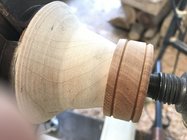
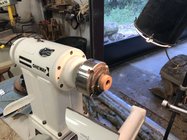 .
.
Last edited:
We can see that this was a 2" diameter tenon that broke off. I am not surprised. That's not much wood to break. SHow me a 4" tenon that snapped and ill be a little more surprised!First off the Oneway chucks all have the cerated jaws and one can hardly discuss about it if one doesn't have or never use the Oneway chucks, and yes you can order dovetail/smooth jaws for any and all the sizes.
I'm not going to discuss the Vicmark or other chuck makes, what I do know is that I can use the Oneway cerated jaws for the size of tenon that I feel is right for the size of turning, I'm not forced to turn an exact size to fit the chucks jaws.
The other thing about the exact dovetail shape and size, I'm quite sure that a more square tenon shape is better than a too acute shape, of course the Oneway uses straight tenons for holding a tenon and also the dried tenon that was turned larger can still be held just fine with the cerated jaws, or turned round and smaller, though I must admit I use mostly a recess to hold my turnings, as I find id a safer and stronger hold, never had those often told ID'sthat you will split the wood with a recess, I do also know I've never had this (see below) happen.View attachment 43063
What we cant see here is the overall diameter of the piece that broke off. Also, We don't know if it was a beginner that set the stage for this mishap? I wouldn't be surprised if the other piece to this mishap was 10 or more inches OD. If it were, usually it should be ok even if there were a catch, providing the piece was 2" or 3" deep. But what happens to the forces acting on the chuck grip, in comparison, if the blank were 6" deep or 8" deep?
What I am really saying, there are many variables that come into play for safety. Such as the species of wood, density, the condition of the wood, moisture content. etc. I think the dovetail holding method is sound providing that we consider all the other factors. Especially, the tenon size ratio to the hunk of wood you wish to turn. The larger the tenon, the more surface area it's gripping, the lower the risk of a mishap. I will at times use expansion providing there is enough mass after the tenon to support the outward forces of the hold.
- Joined
- Feb 28, 2021
- Messages
- 1,231
- Likes
- 1,091
- Location
- Roulette, PA
- Website
- www.reallyruralwoodworks.com
for my one set of dovetail jaws, I have a gage I made from a piece of 5/8" thick scrap wood... Clamp it in vise and on end grain, (assuming you have a relatively flat face on one side of board) you'd mark out your dovetail angle (typically 7 degrees) - Can use calipers to measure the furthest inboard portion of the diameter of your jaws when they're set where you want them I set them a little "loose" to account for wood compression and/or green turned tenons) and transfer that wodth to the "inboard" narrowest part of your marked dovetails , then strike a line straight down (square to end grain) the board to as long as your jaws are wide (or thereabouts - so open end is able to at least reach to center of tenon) and cut to your line following that marked dovetail angle \__/ - then the "legs" of your gage when they fit over your tenon, you know you've got your angle and diameter about as close to where it needs to be as you might reasonably expect.I'm curious what process folks use to make the perfect circle tenon diameter for dovetail jaws. I usually make my tenons a bit larger to avoid overshooting (undershooting?) and making the tenon too small. Talking about dovetail jaws here.
I have had it happen a time or two. For one thing, it can be simply a defect in the wood (quickly learned how to check for those.. after chucking and every so often after, I can whack the work piece with gouge handle and feel (or in the case of y'all who can hear - Listen) and you can kind of feel when the wood has a "ring" (like a bell) or vibration that doesnt translate to the chuck itself.. )I do also know I've never had this (see below) happen.View attachment 43063
For another thing, that can also happen if your tenon is too tall and the bottom of it bottoms out on your chuck , so face of dovetail jaws don't support the flat on your tenon - It allows the work piece to wobble and tilt and stress the grain of the wood to where it cracks through... (which I also quickly learned, a shallower tenon is better) , as well as not making sure the tenon seats in the chuck before tightening... and of course it's also possible to happen when you have a nasty catch) never happened to me, but I've seen catches that hit so hard they can split a 1" thick bowl in half)
On the occasions of getting a rough turned and dried bowl I always recut the tenon and fit it to a relative jaw size.I believe your axioms need some conditional logic to deal with the green wood and then second turned case. I don’t believe the chuck will close securely on a green turned tenon, after drying.
Like others have mentioned, all but one of my chucks are Oneway with serrated teeth. I don’t worry about exact tenon size very often. I usually make about a 3/16” tenon. With ~1/8” tennons I’ve sometimes had an issue where the second serration matches the bottom such that it wants to push the bowl out slightly as I tighten; as a result I’ve gone to a slightly deeper tenon and often knock off the very edge (<1/16”) so it can’t do this.
On some large green bowls I go with 1/4-5/16”. I don’t every recall sending a piece flying because of a failure of the jaws to grip regardless how close the jaws came to a true circle. I do remember a green ~2 1/2” tenon that ripped and failed similar to Leo’s picture ( should have switched to #3 jaws)…
On the one set of dovetail jaws I use I do pay attention to tenon size so that the jaws grip better.
On some large green bowls I go with 1/4-5/16”. I don’t every recall sending a piece flying because of a failure of the jaws to grip regardless how close the jaws came to a true circle. I do remember a green ~2 1/2” tenon that ripped and failed similar to Leo’s picture ( should have switched to #3 jaws)…
On the one set of dovetail jaws I use I do pay attention to tenon size so that the jaws grip better.
Dave Landers
Beta Tester
I tend to usually make most of my tenons about the same height. Not exactly, but they are usually similar. Close enough.I'm curious what process folks use to make the perfect circle tenon diameter for dovetail jaws. I usually make my tenons a bit larger to avoid overshooting (undershooting?) and making the tenon too small. Talking about dovetail jaws here.
The complication is that the taller/deeper the tenon, the more the diameter changes from the top (outside) of the tenon to the bottom where it meets the base. Do you carefully measure the depth of the tenon and set the starting (top) diameter accordingly? Or always use the same depth of tenon and have a starting diameter that you know works?
If you tend to do about the same, then take a scrap and make a tenon. Re-make it smaller till it fits the chuck as you want. Then measure it at the widest part of the tenon, where you'd mark it to start cutting. Maybe make a simple gauge to capture that size. It'll be close enough for most of your tenons. If you decide you want a shorter tenon on a piece, you know you'll have some room to go a bit smaller. If you want taller, you should go a bit bigger. The size (gauge) gives you a consistent starting point, and some practice gets you the rest of the way.
My gauges (from scrap 1/4" plywood) look like this:
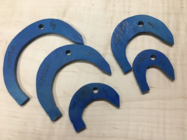
One for each jaw set, and they are sized for me and the way I tend to make tenons. The distance between the point and one square corner is for a tenon, the other corner is for a recess. Blue so I can find them in the chips on the floor. And I marked them with measurements so I can re-make them when/if I break one. To use, I mark a guess at a tenon diameter, check it with the gauge, and repeat till I get close enough (usually less than 2 tries).
odie
TOTW Team
- Joined
- Dec 22, 2006
- Messages
- 7,123
- Likes
- 9,888
The one thing I do I think more than many others I will not turn as fast until my finish cuts and even then less than 900 RPMs. I'm getting to where I can get nice clean cuts at lower speeds than I'm seeing on most demonstrations, probably slower finishing than most turners but I think much safer for me at least.
This is a good point to consider. ^^^^^
Lately, I've been using an 800rpm max, unless the inherent vibration can be adjusted to be less of a contributing factor at another rpm.
Like others have mentioned, all but one of my chucks are Oneway with serrated teeth. I don’t worry about exact tenon size very often.
My chucks are also Oneway Stronghold. Those serrated jaws are great, and I don't worry about the size of the tenon. I make the tenon whatever size needed, without restriction......other than that, there is a small area between the #2 and #3 jaws where neither will fit. That little bit of "no man's land" needs to be avoided. To make sure I don't make any mistakes about this little quirk, I've made up a gauge from a scrap piece of wood that instantly tell me what jaw size to use for the tenon I'm making, plus indicates that little area that no jaws will work. Marked in the shaded red area in the photo.
(edit note: Funny how terminology changes over time. At one time the term "spigot" was one in the same with "tenon".....but, now the latter is much more common! If I'm not mistaken, the term "spigot" was initially entered into my turning vocabulary by Richard Raffan.)
-----odie-----
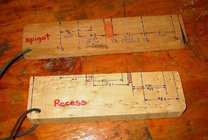
Last edited:
- Joined
- Jan 27, 2005
- Messages
- 12,902
- Likes
- 5,190
- Location
- Dalworthington Gardens, TX
- Website
- pbase.com
If you want to see what the perfect circle diameter looks like for Vicmarc jaws on a Vicmarc 120 chuck, tighten the jaws on a 16 mm diameter drill rod or a Vicmarc Woodworm screw that has a 16 mm in diameter section that is clamped by the jaws.
The gap between the jaws at the perfect circle diameter is 2 mm (which is slightly more than 5/64").
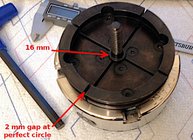
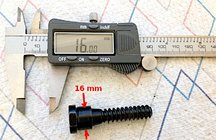
I also use Oneway Stronghold and Talon chucks for most of the things that I turn. While Oneway did make serrated jaws (not sure if they still do) they mainly sell their Premium Profiled jaws. The profiled jaws provide a good gripping surface over the full range of the jaws and don't mar the wood.
The gap between the jaws at the perfect circle diameter is 2 mm (which is slightly more than 5/64").


My chucks are also Oneway Stronghold. Those serrated jaws are great, and I don't worry about the size of the tenon. I make the tenon whatever size needed, without restriction......other than that, there is a small area between the #2 and #3 jaws where neither will fit. That little bit of "no man's land" needs to be avoided.
I also use Oneway Stronghold and Talon chucks for most of the things that I turn. While Oneway did make serrated jaws (not sure if they still do) they mainly sell their Premium Profiled jaws. The profiled jaws provide a good gripping surface over the full range of the jaws and don't mar the wood.
odie
TOTW Team
- Joined
- Dec 22, 2006
- Messages
- 7,123
- Likes
- 9,888
I also use Oneway Stronghold and Talon chucks for most of the things that I turn. While Oneway did make serrated jaws (not sure if they still do) they mainly sell their Premium Profiled jaws. The profiled jaws provide a good gripping surface over the full range of the jaws and don't mar the wood.
Hi Bill.....
Are we speaking of the same thing? I just looked up Oneway Stronghold chucks and jaws on CSUSA, and it appears like the profiled jaws are also serrated.

I think you are correct, that many turners are specifically looking for the un-serreted jaws, for the reason you mention. Personally, I'd prefer the extra gripping power of the serrated jaws. The marks left by the serrated jaws are removed prior to finish turning. Another advantage to the serrated jaws, is it's much easier to align the jaws exactly the same, on subsequent mountings.
Note: On further investigation, it looks like you are referring to what are called "smooth" jaws, and if you look at about 4 o'clock, they look like they are also dovetailed. I believe I have a set of these jaws as well....(I'll have to look to confirm that, though):

-----odie-----
- Joined
- Apr 27, 2004
- Messages
- 8,655
- Likes
- 5,017
- Location
- Lakeland, Florida
- Website
- www.hockenberywoodturning.com
Are we speaking of the same thing? I just looked up Oneway Stronghold chucks and jaws on CSUSA, and it appears like the profiled jaws are also serrated.
I have ONEWAY profiled jaws and ONEWAY dove tail.
The ONEWAY profiled jaws might best be describes as a patented profile with serrations or serrated jaws with a patented profile.
Simple serrated jaws have a circular profile.
The explanation from ONEWAY

Oneway makes 3 versions of jaws: profiled (with serrations, serrated, smooth (dovetail). The serrated and DT are used by other various mfrs. All 3 work, with common rules (flat to concave for jaw top , matching tenon wall profile - straight or dovetail). Dia and tenon length start to diverge a bit depending on jaw type and the “perfect circle” size can vary depending on mfr.
There is also the aspect of whether a jaw type leaves marking or not, and whether that is good or bad.
To teach the subject all 3 should be covered with detailing of the differences. What I typically find with newer turners is their teacher/mentor had preferences and beliefs, and that is what they were taught. In many cases they are unaware of other styles/preferences/beliefs. A good teacher informs about all the possibilities, and explains why they have the preferences that they do (applies to any part of turning not just jaw type), but there are other viable options.
There is also the aspect of whether a jaw type leaves marking or not, and whether that is good or bad.
To teach the subject all 3 should be covered with detailing of the differences. What I typically find with newer turners is their teacher/mentor had preferences and beliefs, and that is what they were taught. In many cases they are unaware of other styles/preferences/beliefs. A good teacher informs about all the possibilities, and explains why they have the preferences that they do (applies to any part of turning not just jaw type), but there are other viable options.
Also note that a recess in a green rough turned piece, which must be made to the size of the circle the same as the dove tenon, the recess will shrink and can be trued up back to that required size.the Oneway uses straight tenons for holding a tenon and also the dried tenon that was turned larger can still be held just fine with the cerated jaws, or turned round and smaller, though I must admit I use mostly a recess to hold my turnings, as I find id a safer and stronger hold, never had those often told ID'sthat you will split the wood with a recess, I do also know I've never had this (see below) happen.
I use the original One Way serrated ( 2 ached serrations per jaw) due to the versatility and if you get a little too aggressive it may slip then all you have to do is loosen and reset the piece. The profile jaws can also grip square stock of varying dimensions.
- Joined
- Apr 27, 2004
- Messages
- 8,655
- Likes
- 5,017
- Location
- Lakeland, Florida
- Website
- www.hockenberywoodturning.com
To teach the subject all 3 should be covered with detailing of the differences.
I agree but when…. And maybe not all in a beginning class. I show them one method and a set of tools that work.
I let them know there are others but avoid the trap of telling them about things they won’t use in the class.
One of the challenges in teaching beginners is deciding what not to tell them yet.
Each person has a limited capacity to learn new things. When short term memory is filled they stop learning in that class.
During down time periods the short term learning gets moved to long term retention freeing space to learn more stuff.
I once helped out in a club ornament class. The instructor started by showing them a bunch of tools they were not going to use and how they worked. By the time he got to the tools he would use in the class, all the eyes had rolled up - an involuntary tell that short term memory was filled - those students would get an ornament from the class with no idea about how to make one the next day.
A counter example - I was doing a club class on bowls. I had demonstrated the bevel riding cuts from foot to rim to rough shape the bowls and wanted them to start turning. The same guy who was one of the assistants asked “don’t you want to explain grain and supporting fibers?” I replied, “No. we are working on bevel riding cuts now. We’ll talk about that later on if we have time”. The key thing here is to not fill their heads with things they don’t need. Later on When I discuss grain orientation. Some will get it some will be overwhelmed with all the new stuff and not retain it but all of them will remember the bevel riding cut on the outside done foot to rim works.
When students ask questions I answer those relevant to what we are doing for the class. Those that may take me down a rabbit hole - I put off politely and either answer them later in the class or individually with student who asked.
Last edited:
@Jamie Straw , to address your original question which was deciding the size of the tenon, I eyeball it. After taking into consideration the demands of the design I ask myself if the planned tenon or mortise looks strong enough.
It's worth mentioning that I use the tailstock as much as possible, and that I am never intentionally aggressive with the tools.
It's worth mentioning that I use the tailstock as much as possible, and that I am never intentionally aggressive with the tools.
Roger Wiegand
Beta Tester
I use Vicmarc chucks and pretty much completely ignore the "perfect circle" advice. I've only done hundreds of bowls, not thousands or tens of thousands, so may not have a statistically significant sample, but out of those I've had, IIRC three tenon failures. Two were where the tenon sheared off, as in Leo's picture above, the other was when the blank sheared in half due to a hidden crack and about a third of it came out of the chuck. Would it have been retained by a "perfect circle" rather than an 8-point grip? Perhaps.
I've never had a sound blank come out the 8-point grip, and I do turn some pretty big (ie for 22-24" bowls) logs and do all my rounding on the lathe, as well as doing coring. I'm sure I take overly aggressive cuts when truing a log, so it's not for want of excess force that I'm not seeing failures. I have had the tenon become too small to use when attempting the "perfect circle" on a twice-turned bowl.
I really just don't see any particular advantage to fussing about the diameter, I'd rather have a big, beefy tenon to help avoid the shearing problem than worry about a problem I've never really had with gripping the tenon. I also find it easier to re-mount bowl fairly exactly by matching the 8 point divots.
Oh-- and I do keep the tailstock engaged when possible, I'm sure that helps.
I've never had a sound blank come out the 8-point grip, and I do turn some pretty big (ie for 22-24" bowls) logs and do all my rounding on the lathe, as well as doing coring. I'm sure I take overly aggressive cuts when truing a log, so it's not for want of excess force that I'm not seeing failures. I have had the tenon become too small to use when attempting the "perfect circle" on a twice-turned bowl.
I really just don't see any particular advantage to fussing about the diameter, I'd rather have a big, beefy tenon to help avoid the shearing problem than worry about a problem I've never really had with gripping the tenon. I also find it easier to re-mount bowl fairly exactly by matching the 8 point divots.
Oh-- and I do keep the tailstock engaged when possible, I'm sure that helps.
With dovetail jaws the depth needs to match the dovetail depth on the chuck jaws. If too deep holding power is reduced. Better to be too shallow than too deep.
Yeah its a Catch-22, and a trap of classes/mentors. I make it a priority that they understand they will be learning a process and methods of A way, not THE way, of doing the project. Other tools/methods are mentioned, not discussed in detail. For those capable and interested it provides other areas to explore. For those struggling to catch on, its quick and painless.I agree but when…. And maybe not all in a beginning class. I show them one method and a set of tools that work.
I let them know there are others but avoid the trap of telling them about things they won’t use in the class.
One of the challenges in teaching beginners is deciding what not to tell them yet.
Each person has a limited capacity to learn new things. When short term memory is filled they stop learning in that class.
During down time periods the short term learning gets moved to long term retention freeing space to learn more stuff.
- Joined
- Jan 27, 2005
- Messages
- 12,902
- Likes
- 5,190
- Location
- Dalworthington Gardens, TX
- Website
- pbase.com
- Joined
- Jan 27, 2005
- Messages
- 12,902
- Likes
- 5,190
- Location
- Dalworthington Gardens, TX
- Website
- pbase.com
Hi Bill.....
Are we speaking of the same thing? I just looked up Oneway Stronghold chucks and jaws on CSUSA, and it appears like the profiled jaws are also serrated.
Odie, apparently, we are speaking of different jaws. Based on your description of how they were used, I assumed that you were referring to the profiled jaws. I think that there are some members of the forum who do call the profiled jaws "serrated". Like a lot of things, the descriptions of woodturning chuck jaws aren't always precise. The serrations on the profiled jaws are rounded over. In a cross-section view, the serrations have a sinusoidal-like appearance. Here is a picture I took of the #3 premium profiled jaws on a Oneway Talon chuck. Unlike the regular serrated jaws which are circular, the profiled jaws have a subtle variation in the curvature which maximizes the contact area over the full expansion range of the jaws. The jaws that Oneway calls smooth are dovetail jaws.
Oneway chuck jaws - profiled vs serrated is describes on their website https://oneway.ca/products-category/chucks . Scroll down below the jaw capacity table and there are diagrams showing the difference.
Their "tower Jaws" are a bit different from standard height jaws. Each size come in round serrated or profiled. but the top 1/4" is actually dovetailed (no serrations).
Their "tower Jaws" are a bit different from standard height jaws. Each size come in round serrated or profiled. but the top 1/4" is actually dovetailed (no serrations).
Oh wel, yes I should have said profiled rather than serrated, but the serrated jaws is what seems to be the understood name for the jaws with the ridges in them.They're covered with wax?
As the profiled and patented jaws are really the jaws that have the added advantage as against the just round serrated jaws, sorry for making this worse as for understanding the differences.
/doug-freeman.
Doug all my and I believe all of the Oneway jaws (but for the smooth jaws) do have the serrations (2 of then) on the outside edge, exactly where you want them, so as to grip right next to the wood on the inside recess.
As for the tower jaws for both Talon/Oneway and Stronghold chucks, they also have the serrations on the outside edge and a wedge like inner edge that can hold/grab a small turned groove or a dovetail like shape on a tenon, got two pictures here of the Talon/Oneway tower jaws and Stronghold tower jaws, there are more jaw sets sizes and types available.
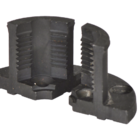
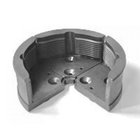
Last edited:
- Joined
- Apr 27, 2004
- Messages
- 8,655
- Likes
- 5,017
- Location
- Lakeland, Florida
- Website
- www.hockenberywoodturning.com
wel, yes I should have said profiled rather than serrated, but the serrated jaws is what seems to be the understood name for the jaws with the ridges in them.
That doesn’t quite match what oneway says.
But you are right that the profiled jaws are serrated.
ONEWAY says their profiled jaws are serrated.

- Joined
- Jan 27, 2005
- Messages
- 12,902
- Likes
- 5,190
- Location
- Dalworthington Gardens, TX
- Website
- pbase.com
Leo, that's a lot clearer picture for showing the shape of profiled jaws than my picture.
Great thread!
I'm curious what you folks (primarily Vicmarc users) choose for jaws in order to properly hold hollow forms in a chuck?
Shark jaws of some type or the same dovetail jaws as for making bowls?
I'm curious what you folks (primarily Vicmarc users) choose for jaws in order to properly hold hollow forms in a chuck?
Shark jaws of some type or the same dovetail jaws as for making bowls?
Last edited:
- Joined
- Jan 27, 2005
- Messages
- 12,902
- Likes
- 5,190
- Location
- Dalworthington Gardens, TX
- Website
- pbase.com
Great thread!
I'm curious what you folks (primarily Vicmarc users) choose for jaws in order to properly hold hollow forms in a chuck?
Shark jaws of some type or the same dovetail jaws as for making bowls?
I use dovetail jaws and size the tenon to fit the perfect circle diameter. As @Roger Wiegand said, he ignores the perfect circle "rule" and has never had a problem, so it isn't essential if you're a skilled woodturner. But, for anybody who might occasionally get a "Cardiac class" catch while hollowing, I think that a tenon sized to the jaws perfect circle diameter will provide as little more insurance against an unscheduled dismount. I choose what size jaws to use based on what "looks right" based on the diameter and height of the hollowform. I can't quantify what the term "looks right" means, but bigger is better if in doubt.
